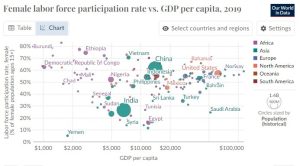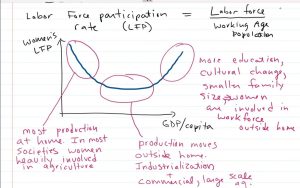According to The World Bank, India ranks 165th out of 187 countries when it comes to the Women’s Labour Force Participation Rate (WLFPR). Only 33% of women here are part of the workforce, contributing ~18% to our GDP.
While I know that comparing us to Western countries may feel unfair due to their smaller population sizes, let’s talk about China here whose population is similar to ours.
China has 61% of their women participating in the labour force, who contribute nearly ~40% to their GDP (as of 2018, and it’s likely even more now).

Why is our representation so low? The reasons aren’t exactly surprising:
- Unpaid domestic work: Indian women spend ~ 9.8x more hours on unpaid domestic chores compared to men. According to an SBI report, this invisible labour contributes ~7.5% to our GDP, yet it goes completely unaccounted for.
- Informal jobs: A huge chunk of women may not get accounted for in the workforce since they work in the unorganised/ informal sector like working in their own farms, working as domestic help, construction labour, etc.
- Stigma: In India, there is still a stigma for working women. Hence many don’t join the formal workforce or leave the workforce after marriage to take care of their kids and household responsibilities.
We need to increase Women’s participation in the Formal Labour workforce


The summary of both the charts? While an increase in women’s participation is desired, it is preferred in the more formal sectors of the economy. As you can see, the countries on the right-hand side of the first chart are those that have a higher women participation in the formal sector. This is where India should move towards to achieve our economic goals.
Womenomics may have answers on how we reach those goals…
We can take inspiration from Japan’s Womenomics which aimed to boost Japan’s GDP by getting more women into the workforce. As a result, Japan’s female labour force participation rate shot up from 64.9% in 2013 to 75.2% in 2023.
- Make our workplaces safer: No matter how many initiatives the government rolls out to boost women’s workforce participation, they won’t succeed without robust safety measures. Incidents like the one at RG Kar Hospital in Kolkata aren’t just societal setbacks — they’re significant roadblocks to our economy too.
- Improve Childcare facility: Make it more accessible and affordable for mothers to avail childcare services whether privately operated or government-funded.
- Increase female leadership: As of FY24, only 18% of senior roles are held by women. Changing this will inspire more women to take up formal work roles.
- Workstyle reforms: Labour reforms are required to reduce overtime hours and mandate equal pay for equal work.
The ripple effect
As more women enter the formal workforce, we might see a shift toward more nuclear families and improved living standards. Women in professional roles would begin outsourcing care work, creating additional jobs and income opportunities, not just in urban areas but in rural regions as well.
This would not only redistribute unpaid care work but also ensure it’s better valued and rewarded – addressing one of the core economic issues we face today.
If India wants to hit that ambitious 8% GDP growth target on a sustainable basis, women will need to make up more than 50% of the new workforce by 2030. But with so many hurdles to overcome, it feels like we have a long road ahead.
Let me know what your thoughts are on this topic.
Till the next time,
Vijay
CEO – InCred Money
P.S. I share my thoughts on Investing and the Economy regularly. You can follow me here.







